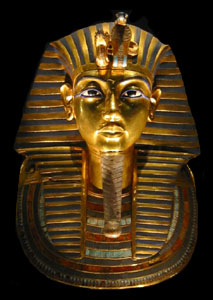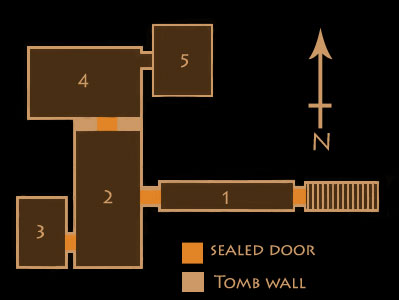
The discovery of the tomb of Tutankhamun caused a sensation and raised the profile of Ancient Egypt with modern tourists and scholars. His tomb had been robbed at least twice before its discovery by Howard Carter but based on the items taken (including perishable oils and perfumes) and the evidence of restoration of the tomb it is likely that these robberies took place fairly soon after the pharaoh’s burial.
The tomb was probably saved from further incursions because its entrance was buried under debris and chips of stone excavated during the construction of other tombs (in particular KV 9 the burial of Rameses VI) and washed there during the infrequent floods which occasionally swept the area. It also seems that worker’s accommodation was built above the location of the entrance during the Rameside period implying that the Egyptians themselves did not know there was a tomb beneath them.

Tutankhamun’s tomb escaped the systematic clearance of tombs in the area conducted during the Twentieth Dynasty motivated in part by a desire to re-house the mummies of pharaohs in a few locations so that they could be better guarded and in part by a rather less worthy desire to recycle their precious grave goods.
Thus, because Tutankhamun was not included in the Abydos kings list, and his tomb entrance was lost below rubble and later habitations, it was relatively intact when it was re-discovered.

Theodore M. Davis and his team uncovered a small site (cache of Tutankhamun – KV 54) containing funerary artefacts bearing the cartouche of Tutankhamun in 1907. Shortly after he excavated the tomb of Horemheb (KV 57) which he assumed was also the tomb of Tutankhamun. In his book detailing his findings (“The Tombs of Harmhabi and Touatankhamanou”) he famously states “I fear that the Valley of Kings is now exhausted”. He was, of course very wrong.
Howard Carter was employed by Lord Carnarvon to search the area for any remaining tombs, but he did not narrow his search to the Tomb of Tutankhamun until he was running out of time. Carnarvon had made it clear that he would only fund one more year of excavations when Carter struck gold with his discovery of the tomb in 1922.
Layout

- Entrance corridor
- Antechamber
- Annex
- Burial Chamber
- Treasury
The tomb of Tutankhamun was one of the smaller tombs of the Valley of the Kings, as Tutankhamun was a fairly minor king who had a very short reign. The tomb is located in an area not usually associated with royal burials perhaps because it may have originally been intended to be the tomb of his Vizier, Ay.
It is suggested that KV 23 or KV 25 (in the West Valley of the Kings) may have originally been intended for his use but as these tombs were unfinished Tutankhamun was buried in KV 62 and Ay later took KV 23 after succeeding Tutankhamun as pharaoh.

Despite its small size, the tomb was crammed with beautiful artefacts, leading many to speculate on the wonders that would have been placed in the tomb of a pharaoh such as Ramesses II or Thuthmosis III. Over three thousand five hundred items were recovered from the burial of Tutankhamun, and many are breathtaking in their beauty and a testament to the skill of Egyptian craftsmen. However, it is now thought that more than half of the jewellery had been stolen from the tomb before it was opened by Howard Carter.
The tomb does not follow the design of the other pharaonic burials of the time. However, Howard Carter suggested that the layout, although apparently different from that of other New Kingdom tombs, replicated the lower sections of more traditional royal tombs. Sixteen steps descend to a sealed and plastered doorway (often erroneously alleged to be the location of the Curse of Tutankhamun).

Beyond this doorway a single descending corridor led to a second sealed door and a rectangular antechamber with a small chamber leading off from the west wall. The doorway in the north end of the antechamber leads to a small burial chamber, the floor of which is around a metre lower than that of the preceding chamber. Another annex (the treasury) extends from the east wall of the burial chamber back towards the entrance.
Decoration
Only the burial chamber in the tomb of Tutankhamun was decorated which is unusual because in royal tombs almost all of the walls were generally painted with scenes from the Amduat (the Book of the Dead). In this case, the burial chamber had a golden background and was decorated with scenes from the Opening of the Mouth ritual and the Amduat (Book of the Dead), and with depictions of Tutankhamun with various gods. There is, unsurprisingly, no reference to the Aten.

The apes of the first hour of the Amduat are depicted on the west wall. On the North wall Tutankhamun appears before the goddess Nut and the royal ka embraces Osiris.
Further along the wall there is a depiction of Ay wearing the blue war crown of a pharaoh (indicating that he became pharaoh shortly after the death of the young king) performing the Opening of the Mouth ritual before the mummy of Tutankhamun.
On the east wall a spell from the Amduat (Book of the Dead) appears, along with a depiction of the funeral procession of Tutankhamun. His mummy is drawn along on a sledge during the funeral procession and he is followed by two of his viziers to the king and a third individual thought by many to be Horemheb.
The decoration on the south wall depicts Tutankhamun with Anubis and Hathor and a further scene depicts Tutankhamun being welcomed into the underworld by Hathor, Anubis, and Isis. The ceiling was decorated with a depiction of Nut with her wings spread to embrace the resting place of the pharaoh.
Nicholas Reeves has suggested that the burial of Nefertiti may lie behind one of the walls of Tutankhamun’s tomb. Zahi Hawass has always vigorously rejected this theory, but some support was given by the interesting but inconclusive radar survey conducted by Mamdouh Eldamaty in 2020. The controversy has been reignited by the discovery of hidden hieroglyphs in 2022. Reeves has suggested that under the cartouches of Ay burying Tutankhamun, he found evidence of the cartouches of Tutankhamun burying Nefertiti (below).

- Tomb of Tutankhamun; page two
- Tutankhamun
- Tutankhamun cache (KV 54)
- Was Tutankhamun murdered?
- “Curse” of Tutankhamun’s tomb
- Ankhesenpaaten (Ankhesenamun)
- Amarna Royal Family
- Amarna Religion
- Amarna Letters
Bibliography
- Bard, Kathryn (2008) An introduction to the Archaeology of Ancient Egypt
- Kemp, Barry J (1991) Ancient Egypt: Anatomy of a Civilisation
- Van Dijk, Jacobus (2000) “The Amarna Period and Later New Kingdom”, in The Oxford History of Ancient Egypt Ed I. Shaw
- Reeves, Nicholas and Wilkinson, Richard H. (1996) The Complete Valley of the Kings
- Strudwick, Nigel and Helen (1999) Thebes in Egypt
Copyright J Hill 2009